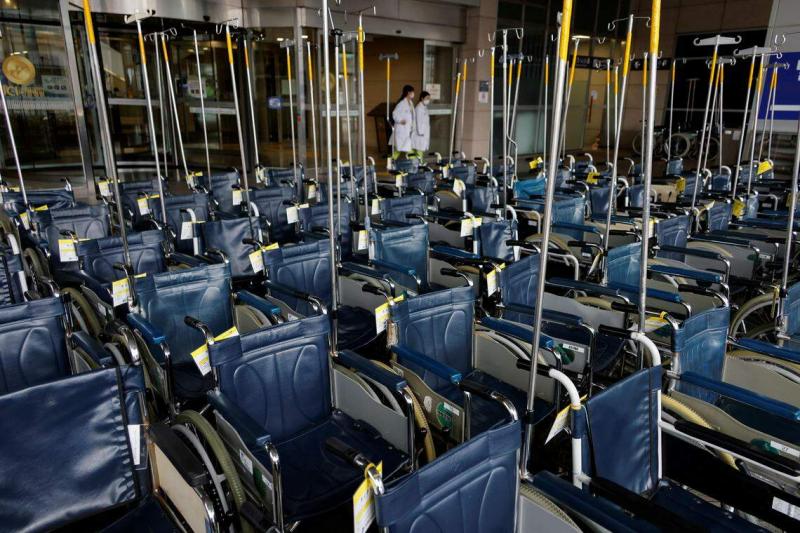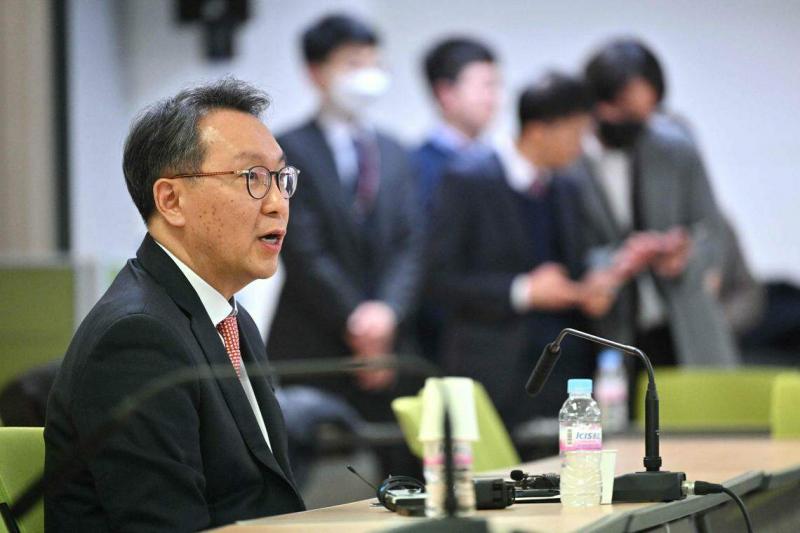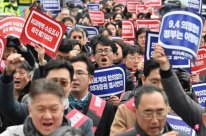
In order to cope with the aging of the population and the shortage of doctors in the field of basic medical care, the South Korean government announced that it began to expand new students from the medical school from the 2025 school year. As a result, it was strongly opposed by the medical industry.Nearly 10,000 doctors have launched a strike, which has continued for two weeks.The contradiction between the medical community and the government has intensified, and the medical system is on the verge of paralysis, which has caused South Korean President Yin Xiyue to face the most severe challenge since ruling.
Zhang Zhenyu (28 years old) at the internship at the Affiliated Hospital of the Seoul Yanshi University submitted a resignation with his classmates last week.In the past few days, he stayed at home to follow the doctor's strike.He is working high -intensity every day in the hospital, and now he is not at work. Zhang Zhenyu bluntly said, but he believes that at this time he should be united with his classmates and speak for Korean medical reform.
At the beginning of February, the South Korean government announced that it will be expanded from next year.The government explained that this is to eliminate the side effects of insufficient doctors in the shortest time.This sudden announcement made Zhang Zhenyu and the inpatients very dissatisfied.Beginning last Monday (February 19), South Korea's internships and inpatients launched collective actions and submitted resignations and strikes one after another.
According to the report of the Ministry of Health and Welfare, about 10,000 internships and inpatients have submitted resignations from 100 large comprehensive hospitals in South Korea, accounting for about 80 % of the internships and inpatients in this hundred hospitals.Their words were not accepted.This group of doctors plan to hold large -scale protests on Sunday (March 3).
Although the government was abducted by the government's license and administrative sanctions, as of the afternoon of Thursday (29th), only 565 intern returned to the post, and there were 8,945 continued strikes.The collective action of doctors seriously affects the operation of major hospitals in South Korea. A large number of surgery and outpatient treatment have been forced to cancel.
This is the fourth large -scale strike that South Korean doctors have been dissatisfied with the government's medical reform since 2000.In 2000, the South Korean government promoted the reform of the "pharmaceutical separation" to solve the disadvantages of doctors who care for medicine with medicines and the excessive medical expenses of ordinary people, leading to a major strike of doctors.Although the reform of the pharmaceutical separation is finally performed according to the plan, the government also compromised, promising to reduce the number of enrollment of medical colleges by 10%, and prohibit the use of drug artists to increase medical expenses.This has also led to the number of admission to the National Medical College of South Korea. Since 2006, it has been limited to 3058 for 18 consecutive years, which is lower than the previous 3507 people.
In 2014, the Park Geun -hye government tried to promote remote medical -related legislation, but shelved due to the large -scale strike of doctors.
The third round of strike was during the epidemic in 2020.At that time, the Korean medical system collapsed due to insufficient manpower, and the Wen Zaiyin government proposed that within 10 years recruited 400 new students in medical schools.Residents and intern doctors immediately launched a strike indefinitely.Considering that the epidemic at that time was serious, Wen Zaiyin's government had to give up.
This time, doctors hope to allow the government to recover the decision through the strike, but the president Yin Xiyue has a tough attitude and has no intention of giving.He said at the State Conference on February 20: "In July 2022, a nurse at a large (Eshan) hospital in Seoul fainted during the hospital and died due to no doctor's surgery. This incident reflected the basic medical treatment of South Korea"Serious situation P>
The biggest reason for the Korean government to expand the students of medical schools is the aging of the population.As of January this year, the total population of South Korea was about 51.75 million, and the population over 65 years of age accounted for about 19.1%. By 2050, this ratio is expected to soar to more than 40%.However, the current medical productivity cannot meet the rapid medical needs of the people.
The Ministry of Health and Welfare of South Korea estimates that the gap between doctors in weak medical fields reaches 5,000. Under the circumstances of aging, the gap between doctors has exceeded 10,000 in 10 years.Only by recruiting 2,000 medical colleges every year, South Korea is expected to fill this gap in 2035 to solve the problem of human shortage in the basic medical field and the collapse of the medical system of rural areas.
The aging of Korean doctors is also worrying.The more difficult the doctor is, the more serious the doctor is.Taking thoracic surgery as an example, among the 1161 patients under the age of 65, 60.8%are more than 50 years old, and the doctor's interrogation is serious.
Yin Xiyue said at the State Conference that Korean medical reforms are imminent, but the previous government has not been able to propose a solution."Medical colleges have not changed each year since 2006. In the past 30 years, although (government) has experienced failure and setbacks, it has now reached the point where it cannot fail."
Doctor: Too poor treatment Dr. Running Basic Medical Field is missing
The Korean Doctor Association has strongly denied that the number of Korean doctors is insufficient.As for the shortage of doctors in a specific basic medical field, the doctor interviewed believes that the problem is that the problem is bad, so the government should first solve the fundamental problem of doctors' treatment.
Economic Cooperation and Development Organization (OECD) data released in November 2023 shows that only 2.6 doctors in South Korea per 1,000 people are not as good as OECD's 3.7 per capita values, ranking the bottom among developed countries.
However, the South Korean Doctor Association pointed out that the number of doctors per 1,000 people in South Korea is actually similar to that of Japan (2.6) and the United States (2.7), and other indicators such as residents and hospitals, the average number of residents, and the number of hospitalization days.The top of OECD is among the best.

However, due to the uneven distribution of talents in the medical field, some departments are indeed insufficient, and the waiting time for appointment is long.This phenomenon mainly appears in the basic medical field, namely internal medicine, surgery, obstetrics and gynecology, and pediatrics.
Zhang Zhenyu, an intern who has decided to join the army in March, told the United Zhenzao that his father and grandfather were doctors, maybe they were dazzling or inherited by the doctor. Under their influence, he unswervingly chose the profession of a doctor.However, when the intern is really tired.
He said: "Although the law stipulates that doctors work for 80 hours a week, our interns have to work overtime almost every day. I used to work 110 hours a week. This phenomenon is not that the number of doctors can be solved, but because of the medical fieldCauses of vicious cycles formed by uneven distribution of talents.
He revealed that no one applied for the school medical school this year to join the pediatric department. Even if there were classmates interested, they finally worried that the pressure was too great and gave up.
Zhang Zhenyu said: "Compared to the government's expansion of medical students, it is more important to improve the working environment of the basic medical field.It is really difficult to understand the plan to expand students."
It is understood that the internships and inpatients in different professional fields are different.For example, internships and inpatient doctors must assist in the attending doctors to prepare the surgery room and observe the patient after surgery and observe the patient. It is commonplace for more than 80 hours a week.But in large hospitals, their average salary is only about 3.8 million to 4 million won (S $ 3831 to 4033).
Hospital excessive dependence on internship and inpatient doctor
Zhao Dongcan, a reporter from the SBS TV Medical Line of Dr. Zhao Dongcan, analyzed in the show: "At present, there are 140,000 doctors in South Korea, of which 10,000 internships and inpatients leave their jobs, and the medical community is almost paralyzed. This can explain that it can explainThe Korean medical system seriously relies on the reality of internship and inpatient doctors.
According to Zhao Dongcan, large hospitals in the United States and Japan, internships and inpatients only account for about 10%of the doctors, but at the Hospital of Seoul University, internship and inpatients account for 46%.
Medical staff has a large hospital that criticizes basic medical services. In order to chase maximized profits, it is too cheap to hire a specialist doctor.
 In order to avoid paralysis of the medical system, the Korean government will send military doctors to large hospitals to assist in large hospitals in order to avoid paralysis of medical systems and authorize nurses to take more positions.(Reuters)
In order to avoid paralysis of the medical system, the Korean government will send military doctors to large hospitals to assist in large hospitals in order to avoid paralysis of medical systems and authorize nurses to take more positions.(Reuters) 




